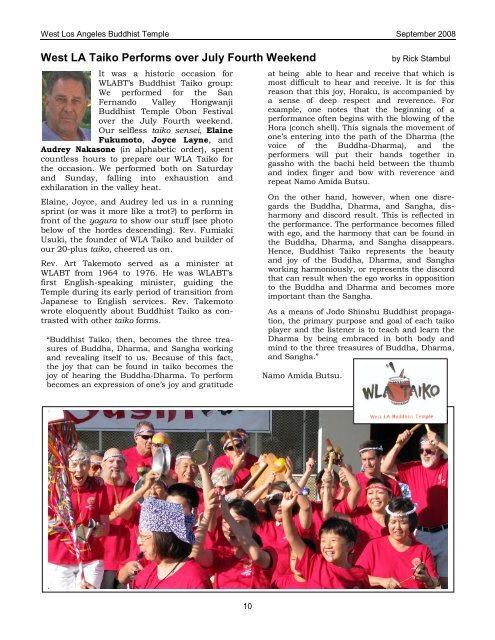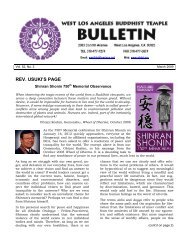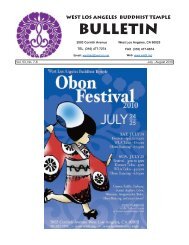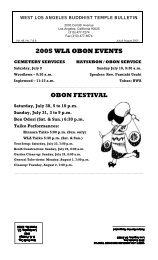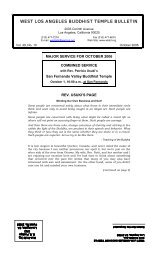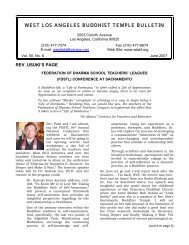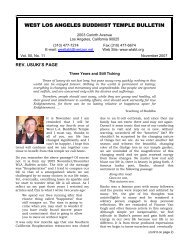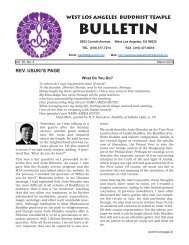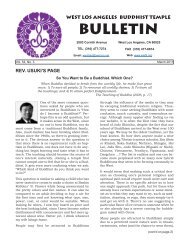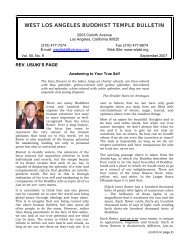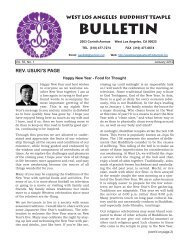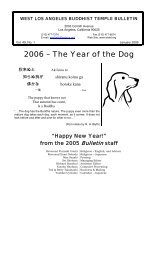2008 September Bulletin - West Los Angeles Buddhist Temple
2008 September Bulletin - West Los Angeles Buddhist Temple
2008 September Bulletin - West Los Angeles Buddhist Temple
You also want an ePaper? Increase the reach of your titles
YUMPU automatically turns print PDFs into web optimized ePapers that Google loves.
<strong>West</strong> <strong>Los</strong> <strong>Angeles</strong> <strong>Buddhist</strong> <strong>Temple</strong> <strong>September</strong> <strong>2008</strong><br />
<strong>West</strong> LA Taiko Performs over July Fourth Weekend<br />
It was a historic occasion for<br />
WLABT’s <strong>Buddhist</strong> Taiko group:<br />
We performed for the San<br />
Fernando Valley Hongwanji<br />
<strong>Buddhist</strong> <strong>Temple</strong> Obon Festival<br />
over the July Fourth weekend.<br />
Our selfless taiko sensei, Elaine<br />
Fukumoto, Joyce Layne, and<br />
Audrey Nakasone (in alphabetic order), spent<br />
countless hours to prepare our WLA Taiko for<br />
the occasion. We performed both on Saturday<br />
and Sunday, falling into exhaustion and<br />
exhilaration in the valley heat.<br />
Elaine, Joyce, and Audrey led us in a running<br />
sprint (or was it more like a trot?) to perform in<br />
front of the yagura to show our stuff (see photo<br />
below of the hordes descending). Rev. Fumiaki<br />
Usuki, the founder of WLA Taiko and builder of<br />
our 20-plus taiko, cheered us on.<br />
Rev. Art Takemoto served as a minister at<br />
WLABT from 1964 to 1976. He was WLABT’s<br />
first English-speaking minister, guiding the<br />
<strong>Temple</strong> during its early period of transition from<br />
Japanese to English services. Rev. Takemoto<br />
wrote eloquently about <strong>Buddhist</strong> Taiko as contrasted<br />
with other taiko forms.<br />
“<strong>Buddhist</strong> Taiko, then, becomes the three treasures<br />
of Buddha, Dharma, and Sangha working<br />
and revealing itself to us. Because of this fact,<br />
the joy that can be found in taiko becomes the<br />
joy of hearing the Buddha-Dharma. To perform<br />
becomes an expression of one’s joy and gratitude<br />
by Rick Stambul<br />
at being able to hear and receive that which is<br />
most difficult to hear and receive. It is for this<br />
reason that this joy, Horaku, is accompanied by<br />
a sense of deep respect and reverence. For<br />
example, one notes that the beginning of a<br />
performance often begins with the blowing of the<br />
Hora (conch shell). This signals the movement of<br />
one’s entering into the path of the Dharma (the<br />
voice of the Buddha-Dharma), and the<br />
performers will put their hands together in<br />
gassho with the bachi held between the thumb<br />
and index finger and bow with reverence and<br />
repeat Namo Amida Butsu.<br />
On the other hand, however, when one disregards<br />
the Buddha, Dharma, and Sangha, disharmony<br />
and discord result. This is reflected in<br />
the performance. The performance becomes filled<br />
with ego, and the harmony that can be found in<br />
the Buddha, Dharma, and Sangha disappears.<br />
Hence, <strong>Buddhist</strong> Taiko represents the beauty<br />
and joy of the Buddha, Dharma, and Sangha<br />
working harmoniously, or represents the discord<br />
that can result when the ego works in opposition<br />
to the Buddha and Dharma and becomes more<br />
important than the Sangha.<br />
As a means of Jodo Shinshu <strong>Buddhist</strong> propagation,<br />
the primary purpose and goal of each taiko<br />
player and the listener is to teach and learn the<br />
Dharma by being embraced in both body and<br />
mind to the three treasures of Buddha, Dharma,<br />
and Sangha.”<br />
Namo Amida Butsu.<br />
10


